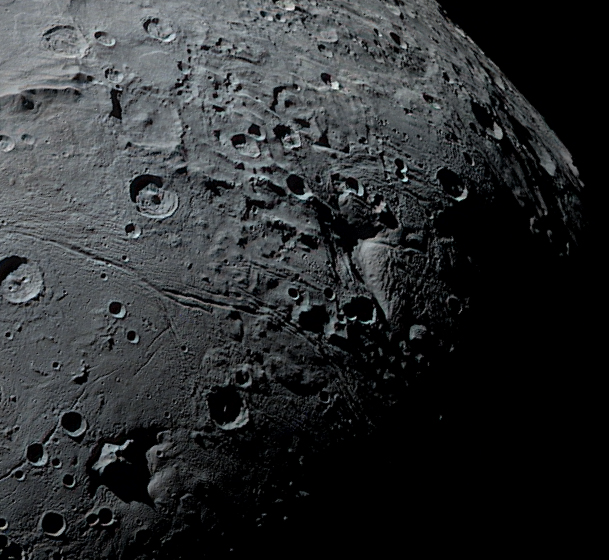It looks like you're using an Ad Blocker.
Please white-list or disable AboveTopSecret.com in your ad-blocking tool.
Thank you.
Some features of ATS will be disabled while you continue to use an ad-blocker.
23
share:
Prior to the New Horizons probe doing it's flyby of Pluto and Charon last year, there certainly was not a whole lot to look at as far as Charon goes
except as a hand full of pixels on a screen for most.
Discovered in 1978 by James Christy at the United States Naval Observatory, interestingly it was not because of blink movement, or seeing the body actually move around Pluto, but rather because Pluto kept getting a bump. As in a lump on it's side. In reality it was Charon peeking out.
With the New Horizons flyby, proves quite nicely that having a spacecraft with a high resolution camera and telescope on board gives us some of the most spectacular images that people can pour over:
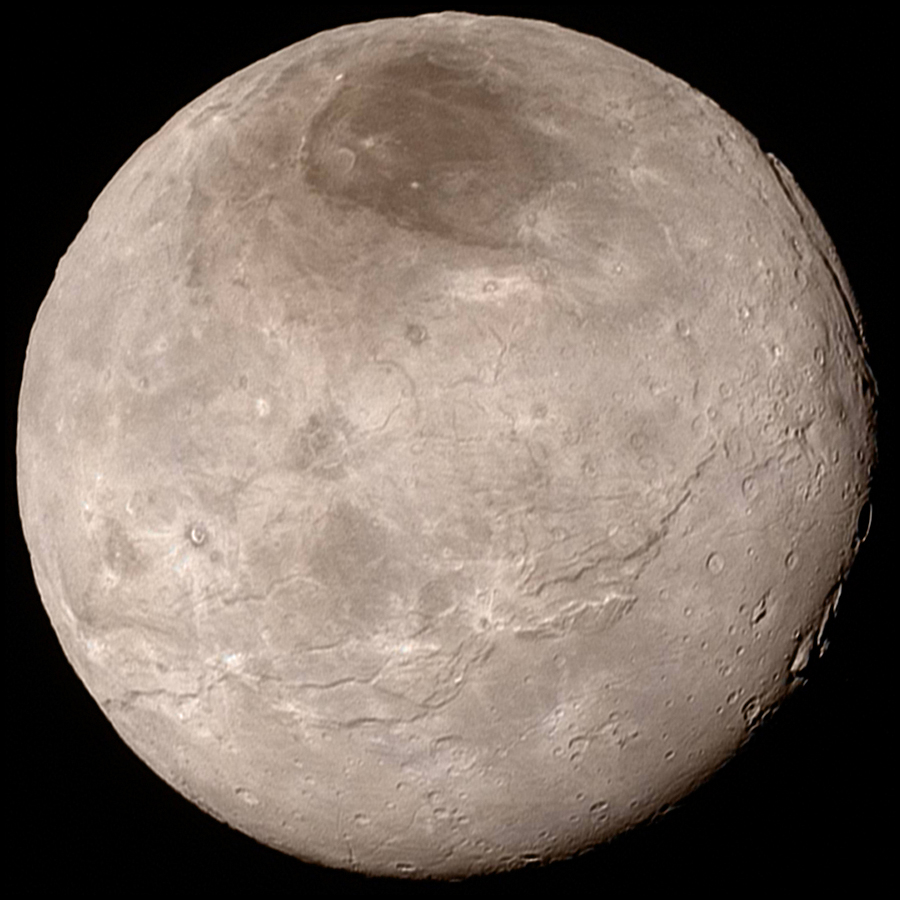
Charon (officially pronounced with a hard "K" sound, but is more commonly pronounced with the "Sh" sound even by many astronomers and NASA), is a small body that is bigger than the dwarf planet Ceres. However it's half the size of it's parent body Pluto. Normally that would make it the biggest moon in relation to it's parent body, but due to the fact that Pluto was downgraded from full planet status to dwarf planet, that means our own Moon and Earth has that distinction. Neither our Moon or Charon hold the distinction of being the biggest moon in our solar system. That award goes to Jupiter's moon Ganymede, which is actually bigger than the planet Mercury!
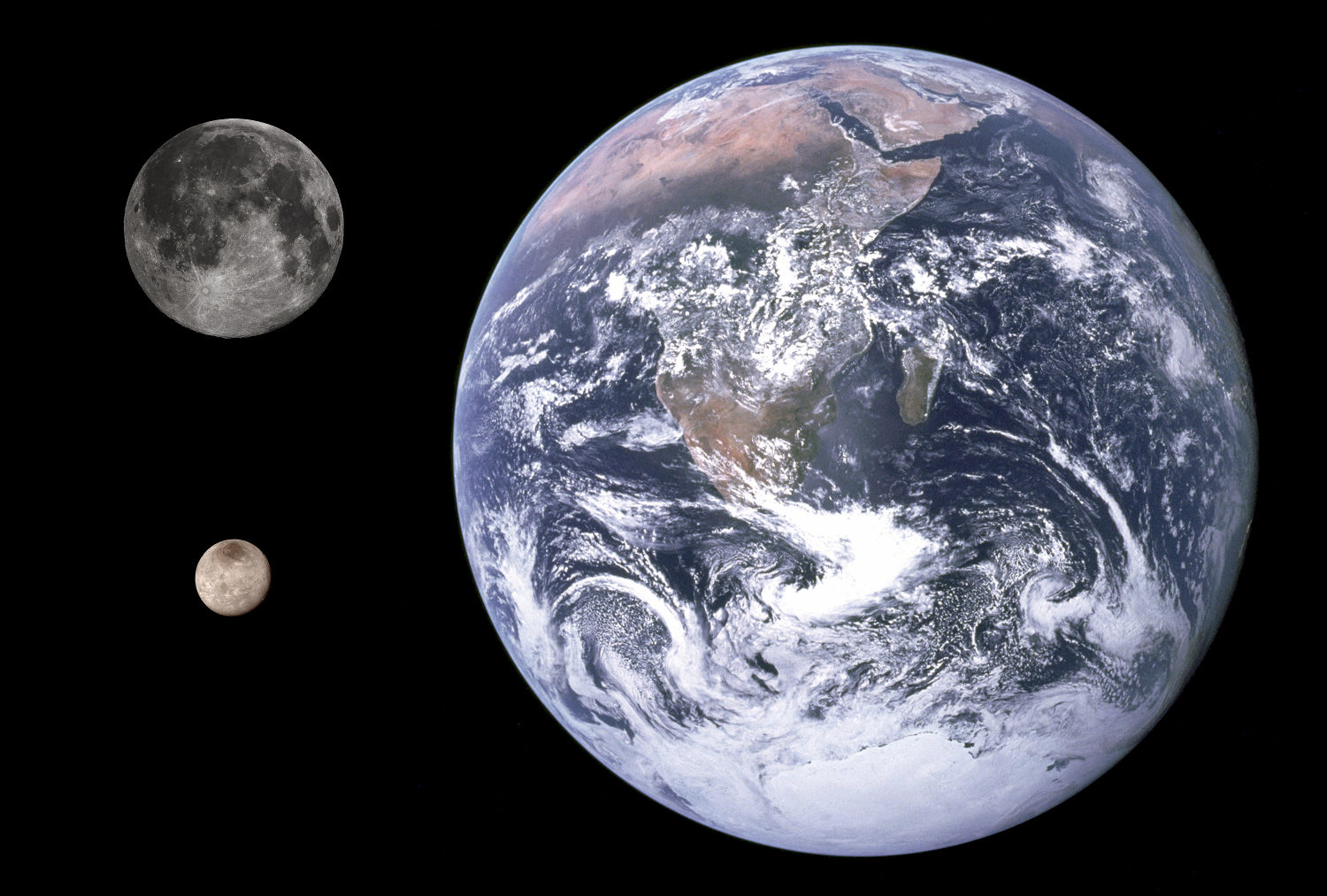
Because Charon is so big as compared to Pluto, both it and Pluto share a special type of orbital movement. Instead of Charon orbiting about Pluto as the Moon orbits about our planet, both Pluto and Charon orbit about a point in space, always keeping the same face to each other:
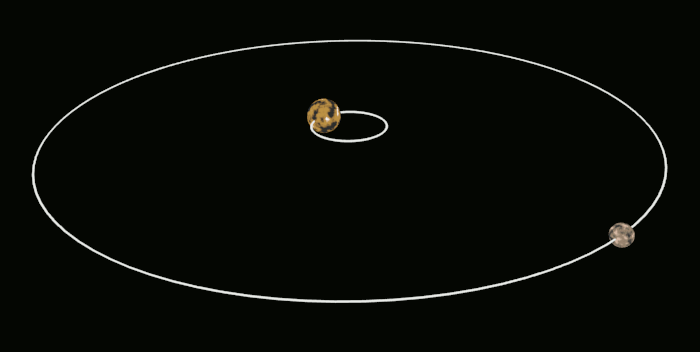
Charon's surface appears to have a surface of mostly water ice with patches of ammonia hydrates on it. Those patches suggest that, at least in it's past, Charon has cryrovolcanos or cryrogysers on it. In the following image, who's color has been enhanced to show the different make ups of the surface (and which I love to look at), we can see darker areas like the north polar region. The darker norther region, called Mordor by the New Horizons team (at -258 deg C, I bet even Sauron would be cold) has the darker hues due to chemical reactions from sun light with nitrogen, carbon monoxide, and methane in their solid form. Yes...solid form. It's that cold there!
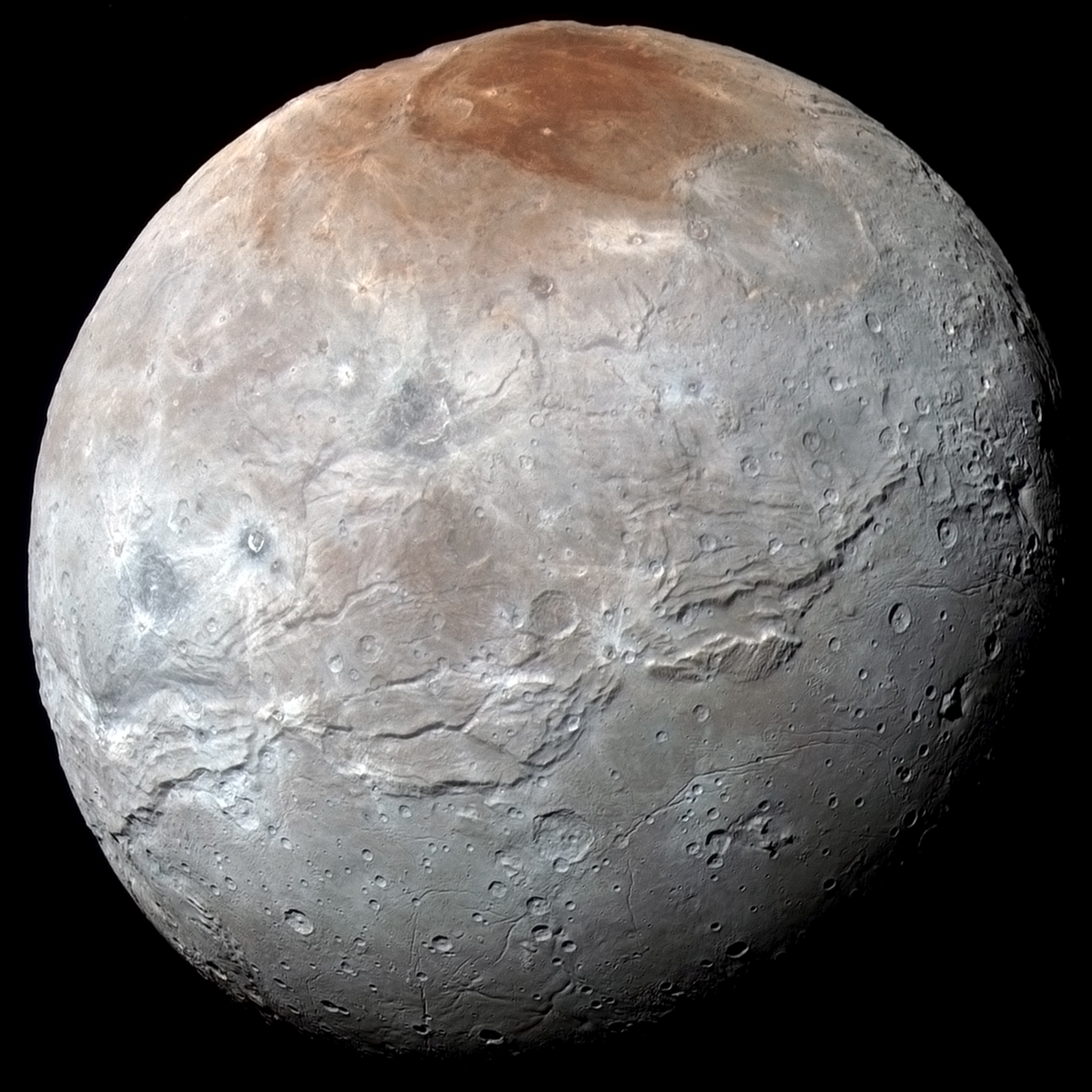
Looking over the above image is always fascinating to me. Comparing Charon with our Moon, especially the far side of the Moon, our Moon looks like someone really had a beef with it, and shot it so many times with meteor impacts, that you can't find too many places that do not have craters! Charon has so little in the way of craters.
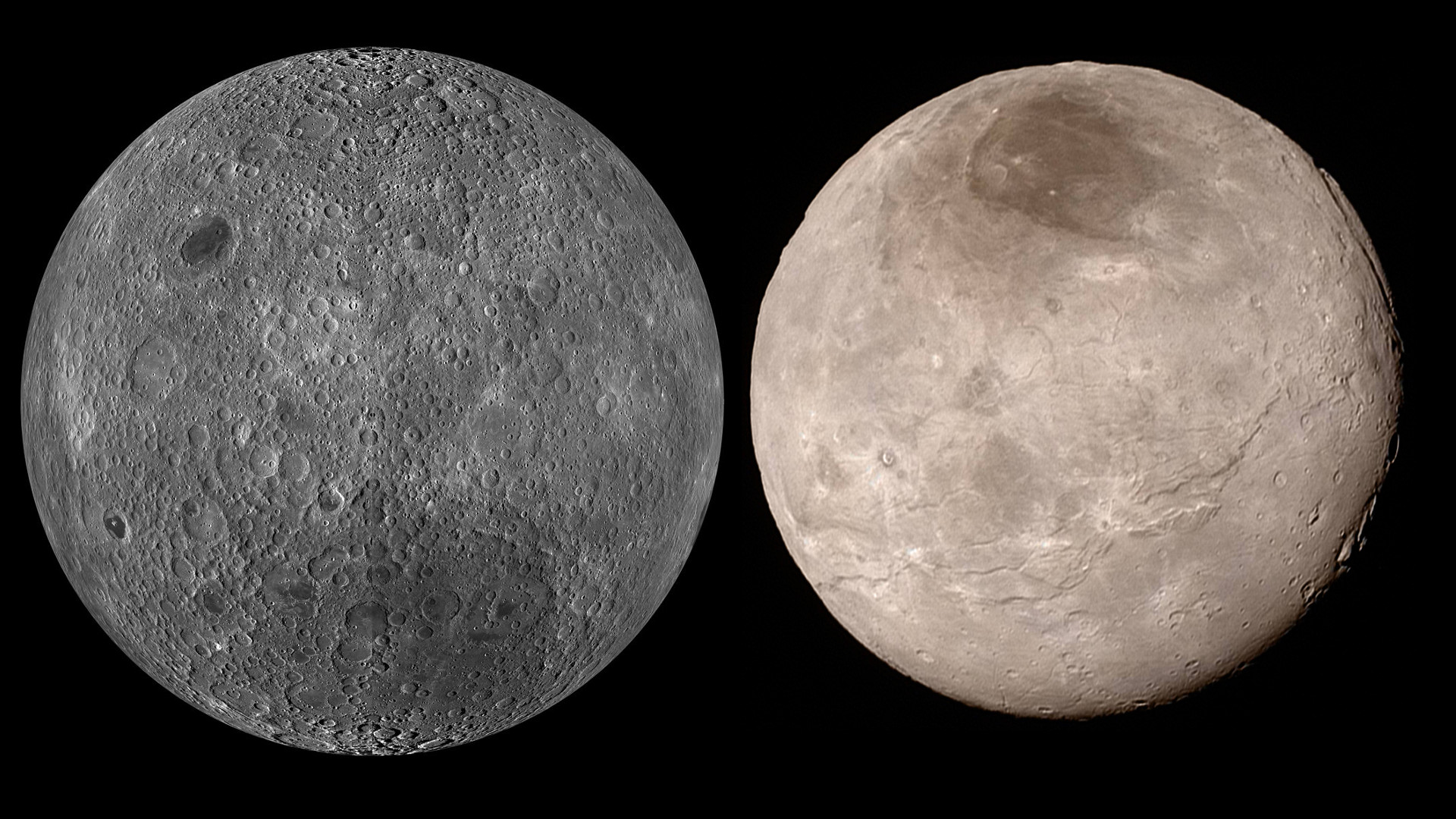
However, that does not detract from the fact that to me, Charon looks like someone beat the snot out of it. It appears dented, cracked and basically broken in many ways. This gives it many different features that I find amazing:

The Lonely Mountain:
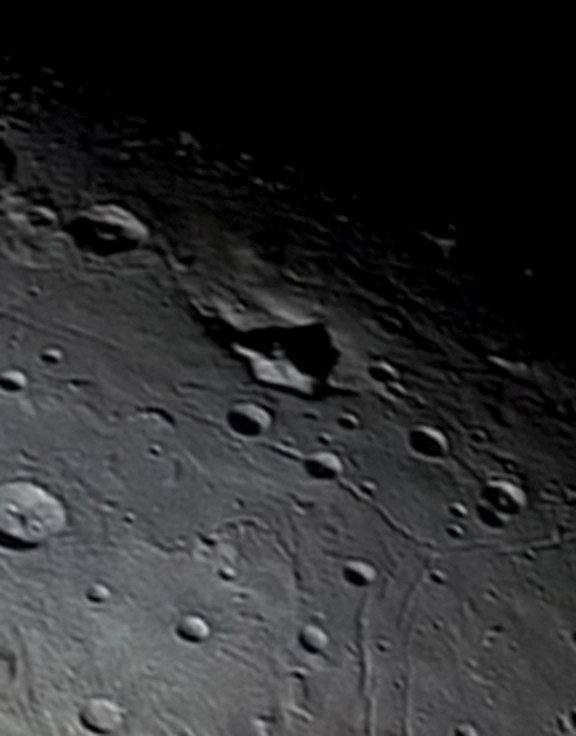
Looks like one heck of a crack to me:
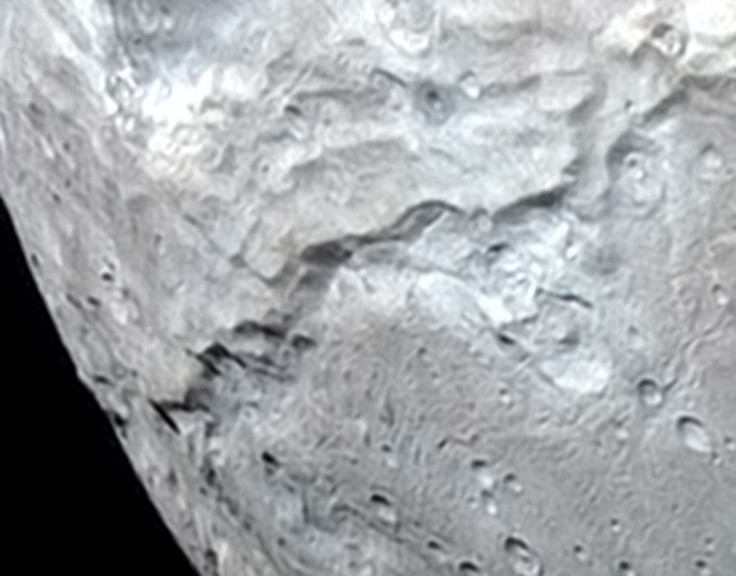
And now for some pop culture trivia about Charon!
Charon is featured in two video games, Descent which is a 3D first person shooter game that was released back in 1995 for PlayStation, where the final level has you on what is suppose to be Charon, and the Mass Effect game series, where Charon was suppose to be an icy body that inside contained a Mass Relay that allowed humanity to make FTL jumps from our solar system to other parts of the galaxy. In Mass Effect, when humanity started using the Mass Relay in orbit around Pluto, it caused Pluto's orbit to become more circular.
From the video game "Descent":
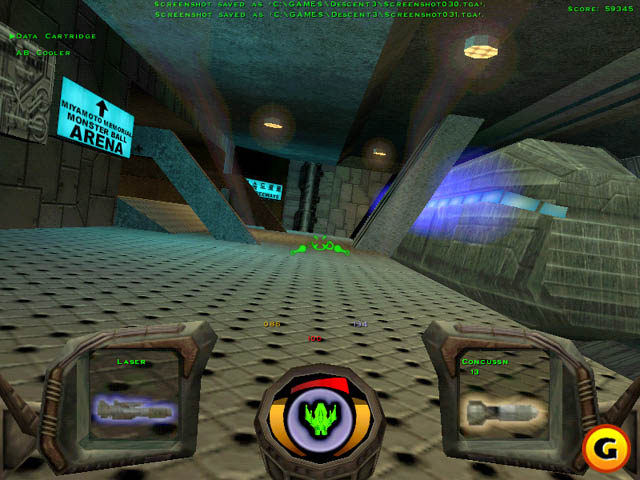
A mass relay from the game series Mass Effect:
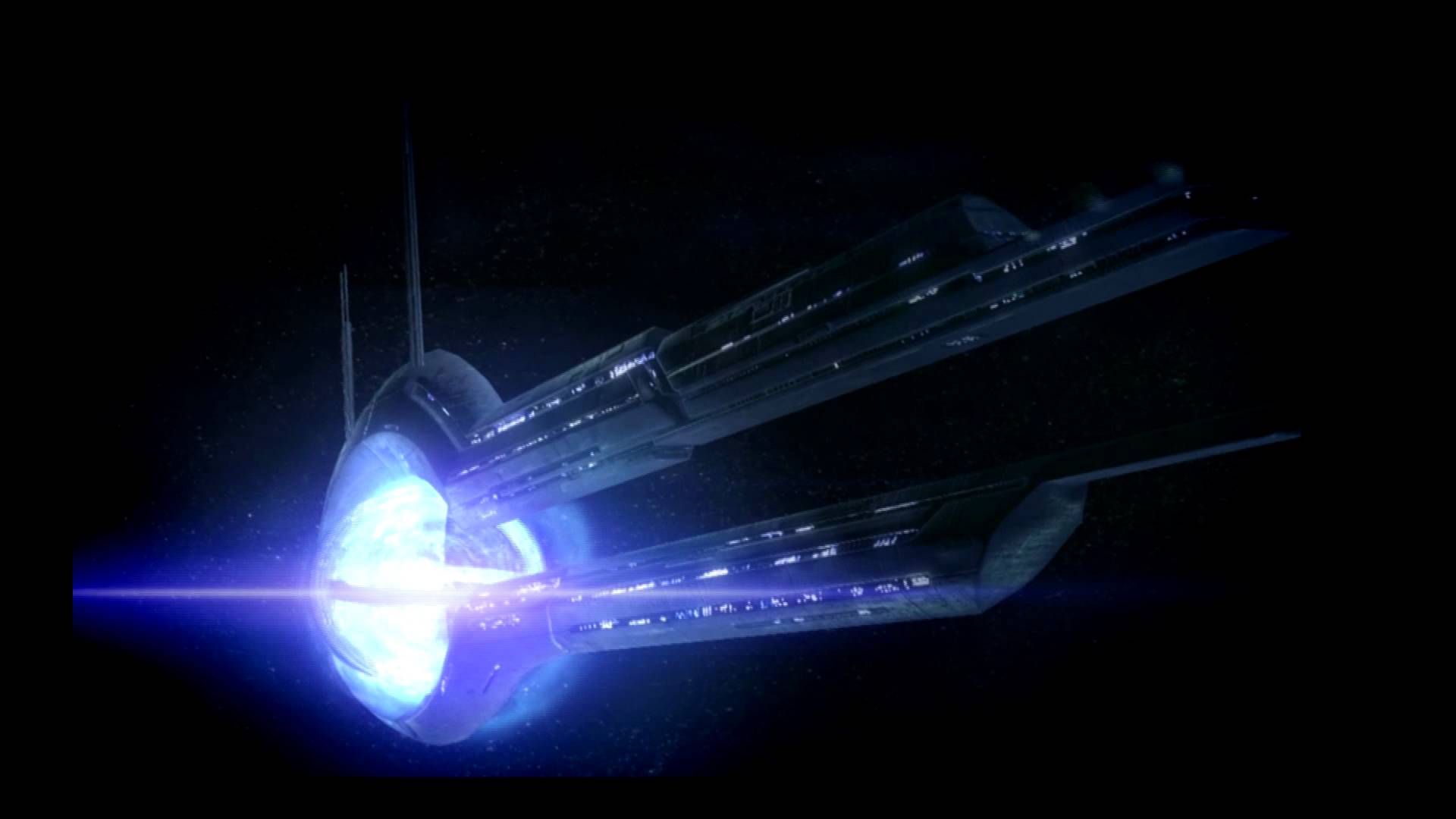
Jonathan Coulton's song "I'm Your Moon" is suppose to be a love song, sung by Charon to Pluto:
And if you're wondering why his name sounds familiar...or the musical style does, it may be because he wrote both the ending credit songs for the games Portal and Portal 2:
Discovered in 1978 by James Christy at the United States Naval Observatory, interestingly it was not because of blink movement, or seeing the body actually move around Pluto, but rather because Pluto kept getting a bump. As in a lump on it's side. In reality it was Charon peeking out.
With the New Horizons flyby, proves quite nicely that having a spacecraft with a high resolution camera and telescope on board gives us some of the most spectacular images that people can pour over:

Charon (officially pronounced with a hard "K" sound, but is more commonly pronounced with the "Sh" sound even by many astronomers and NASA), is a small body that is bigger than the dwarf planet Ceres. However it's half the size of it's parent body Pluto. Normally that would make it the biggest moon in relation to it's parent body, but due to the fact that Pluto was downgraded from full planet status to dwarf planet, that means our own Moon and Earth has that distinction. Neither our Moon or Charon hold the distinction of being the biggest moon in our solar system. That award goes to Jupiter's moon Ganymede, which is actually bigger than the planet Mercury!

Because Charon is so big as compared to Pluto, both it and Pluto share a special type of orbital movement. Instead of Charon orbiting about Pluto as the Moon orbits about our planet, both Pluto and Charon orbit about a point in space, always keeping the same face to each other:

Charon's surface appears to have a surface of mostly water ice with patches of ammonia hydrates on it. Those patches suggest that, at least in it's past, Charon has cryrovolcanos or cryrogysers on it. In the following image, who's color has been enhanced to show the different make ups of the surface (and which I love to look at), we can see darker areas like the north polar region. The darker norther region, called Mordor by the New Horizons team (at -258 deg C, I bet even Sauron would be cold) has the darker hues due to chemical reactions from sun light with nitrogen, carbon monoxide, and methane in their solid form. Yes...solid form. It's that cold there!

Looking over the above image is always fascinating to me. Comparing Charon with our Moon, especially the far side of the Moon, our Moon looks like someone really had a beef with it, and shot it so many times with meteor impacts, that you can't find too many places that do not have craters! Charon has so little in the way of craters.

However, that does not detract from the fact that to me, Charon looks like someone beat the snot out of it. It appears dented, cracked and basically broken in many ways. This gives it many different features that I find amazing:

The Lonely Mountain:

Looks like one heck of a crack to me:

And now for some pop culture trivia about Charon!
Charon is featured in two video games, Descent which is a 3D first person shooter game that was released back in 1995 for PlayStation, where the final level has you on what is suppose to be Charon, and the Mass Effect game series, where Charon was suppose to be an icy body that inside contained a Mass Relay that allowed humanity to make FTL jumps from our solar system to other parts of the galaxy. In Mass Effect, when humanity started using the Mass Relay in orbit around Pluto, it caused Pluto's orbit to become more circular.
From the video game "Descent":

A mass relay from the game series Mass Effect:

Jonathan Coulton's song "I'm Your Moon" is suppose to be a love song, sung by Charon to Pluto:
And if you're wondering why his name sounds familiar...or the musical style does, it may be because he wrote both the ending credit songs for the games Portal and Portal 2:
Nice thread Erik.. Thanks for that thread, good presentation.
Always excited when one of these missions flys out to distant planets and moons.. And although this is an amazing achievement and we'll worth every dollar spent.. I'm always a little disappointed when I see the images and it's just another barren rock floating in space..
Station and flag for you my good man..
Always excited when one of these missions flys out to distant planets and moons.. And although this is an amazing achievement and we'll worth every dollar spent.. I'm always a little disappointed when I see the images and it's just another barren rock floating in space..
Station and flag for you my good man..
a reply to: Misterlondon
Ditto well done !
Nice thread Erik.. Thanks for that thread, good presentation.
Ditto well done !
a reply to: eriktheawful
Getting better all the time as they download and image the data.Thanks for the look at Charon.
You're right, it looks hammered to me, too.
Like dropping a hard boiled egg on the floor... maybe whatever hit it that hard is reflected in a massive crater on the opposite side? Or does the tidally locked orbit with Pluto exert such force on one side Charon is being 'pulled' slowly apart?
Poor Puto, its not a planet, anymore...
pffft...
With the New Horizons flyby, proves quite nicely that having a spacecraft with a high resolution camera and telescope on board gives us some of the most spectacular images that people can pour over:
Getting better all the time as they download and image the data.Thanks for the look at Charon.
You're right, it looks hammered to me, too.
Like dropping a hard boiled egg on the floor... maybe whatever hit it that hard is reflected in a massive crater on the opposite side? Or does the tidally locked orbit with Pluto exert such force on one side Charon is being 'pulled' slowly apart?
Poor Puto, its not a planet, anymore...
pffft...
edit on 27-8-2016 by intrptr because: spelling
a reply to: eriktheawful
Nice to see and learn something new everyday.
Thanks for the read, great pics and music.
Kind regards,
Bally
Nice to see and learn something new everyday.
Thanks for the read, great pics and music.
Kind regards,
Bally
a reply to: eriktheawful
You get the prize for the longest avatar background, ever!
Charon (which I always pronounce as "Sharon" aka Ozzy Osbourne's wife) is an exciting and mysterious object to study, make no mistake. Pluto-Charon is practically a double dwarf planet system.
We're so honoured to have these images, considering that we won't see any more for many years to come.
You get the prize for the longest avatar background, ever!
Charon (which I always pronounce as "Sharon" aka Ozzy Osbourne's wife) is an exciting and mysterious object to study, make no mistake. Pluto-Charon is practically a double dwarf planet system.
We're so honoured to have these images, considering that we won't see any more for many years to come.
new topics
-
Federal law trumps state and local law every time
Social Issues and Civil Unrest: 8 hours ago
top topics
-
Federal law trumps state and local law every time
Social Issues and Civil Unrest: 8 hours ago, 14 flags
active topics
-
Remember These Attacks When President Trump 2.0 Retribution-Justice Commences.
2024 Elections • 94 • : xuenchen -
Well, here we go red lines crossed Biden gives the go ahead to use long range missiles
World War Three • 383 • : andy06shake -
I thought Trump was the existential threat?
World War Three • 77 • : EyeoftheHurricane -
Federal law trumps state and local law every time
Social Issues and Civil Unrest • 18 • : StoutBroux -
The Acronym Game .. Pt.4
General Chit Chat • 993 • : JJproductions -
The Reactionary Conspiracy 6. Modus Operandi II
General Conspiracies • 137 • : MarxistDebunker2 -
President-Elect DONALD TRUMP's 2nd-Term Administration Takes Shape.
Political Ideology • 253 • : network dude -
The Reactionary Conspiracy 13. The plot’s theology.
General Conspiracies • 315 • : andy06shake -
Comcast dumping MSNBC
Mainstream News • 34 • : xuenchen -
Interesting Video-UFO?
Aliens and UFOs • 15 • : devilhunter69
23


